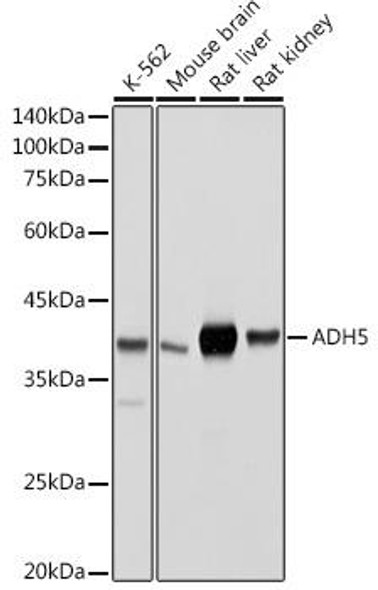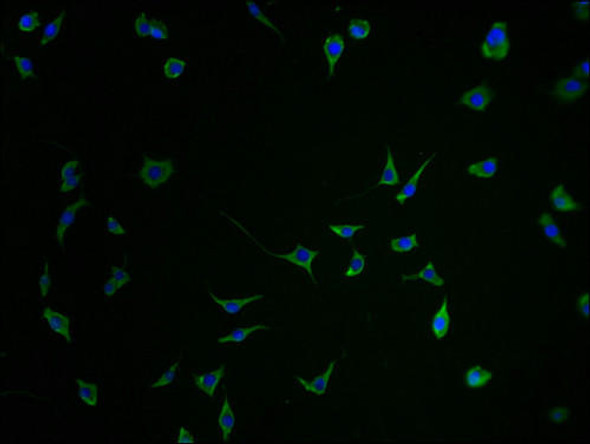Description
Adh5 Antibody (PACO24775)
The ADH5 Polyclonal Antibody (PACO24775) is a valuable tool for research involving the ADH5 protein, an enzyme that plays a key role in alcohol metabolism and detoxification. This antibody, produced in rabbits, exhibits high reactivity with human samples and is validated for use in applications such as Western blotting. By targeting the ADH5 protein, researchers can detect and analyze its expression in various cell types, making it an essential tool for studies in pharmacology, toxicology, and alcohol-related research.ADH5, also known as alcohol dehydrogenase 5, is a crucial enzyme involved in the breakdown of alcohol in the liver.
Understanding the function of ADH5 is essential for investigating alcohol metabolism, alcohol-related diseases, and potential therapies for alcohol toxicity. By studying the activity of ADH5, researchers can gain insights into the mechanisms of alcohol metabolism and its impact on human health. This antibody is a valuable resource for researchers investigating the role of ADH5 in alcohol metabolism and related processes.
| Antibody Name: | Adh5 Antibody (PACO24775) |
| Antibody SKU: | PACO24775 |
| Size: | 50ug |
| Host Species: | Rabbit |
| Tested Applications: | ELISA, WB |
| Recommended Dilutions: | ELISA:1:2000-1:10000, WB:1:1000-1:5000 |
| Species Reactivity: | Mouse |
| Immunogen: | Recombinant Mouse Alcohol dehydrogenase class-3 protein (2-374AA) |
| Form: | Liquid |
| Storage Buffer: | Preservative: 0.03% Proclin 300 Constituents: 50% Glycerol, 0.01M PBS, PH 7.4 |
| Purification Method: | >95%, Protein G purified |
| Clonality: | Polyclonal |
| Isotype: | IgG |
| Conjugate: | Non-conjugated |
 | Western blot All lanes: Adh5 antibody at 2µg/ml Lane 1: Mouse liver tissue Lane 2: Mouse kidney tissue Secondary Goat polyclonal to rabbit IgG at 1/10000 dilution Predicted band size: 40 kDa Observed band size: 40 kDa . |
| Background: | Class-III ADH is remarkably ineffective in oxidizing ethanol, but it readily catalyzes the oxidation of long-chain primary alcohols and the oxidation of S-(hydroxymethyl) glutathione. |
| Synonyms: | Alcohol dehydrogenase class-3 (EC 1.1.1.1) (Alcohol dehydrogenase 2) (Alcohol dehydrogenase 5) (Alcohol dehydrogenase B2) (ADH-B2) (Alcohol dehydrogenase class-III) (Glutathione-dependent formaldehyde dehydrogenase) (FALDH) (FDH) (GSH-FDH) (EC 1.1.1.-) (S-(hydroxymethyl)glutathione dehydrogenase) (EC 1.1.1.284), Adh5, Adh-2 Adh2 |
| UniProt Protein Function: | ADH5: Class-III ADH is remarkably ineffective in oxidizing ethanol, but it readily catalyzes the oxidation of long-chain primary alcohols and the oxidation of S-(hydroxymethyl) glutathione. Belongs to the zinc-containing alcohol dehydrogenase family. Class-III subfamily.Protein type: Xenobiotic Metabolism - metabolism by cytochrome P450; Oxidoreductase; Cofactor and Vitamin Metabolism - retinol; Xenobiotic Metabolism - drug metabolism - cytochrome P450; Carbohydrate Metabolism - glycolysis and gluconeogenesis; Amino Acid Metabolism - tyrosine; Energy Metabolism - methane; Mitochondrial; EC 1.1.1.284; EC 1.1.1.1; Lipid Metabolism - fatty acidCellular Component: mitochondrion; cytoplasm; nucleusMolecular Function: mevaldate reductase activity; protein homodimerization activity; zinc ion binding; metal ion binding; oxidoreductase activity; C-3 sterol dehydrogenase (C-4 sterol decarboxylase) activity; (R)-2-hydroxyisocaproate dehydrogenase activity; steroid dehydrogenase activity; D-arabinitol dehydrogenase (NADP+) activity; fatty acid binding; acetoin dehydrogenase activity; gluconate dehydrogenase activity; (R)-2-hydroxyglutarate dehydrogenase activity; phenylcoumaran benzylic ether reductase activity; aldo-keto reductase activity; formaldehyde dehydrogenase activity; alcohol dehydrogenase activity; arabinose reductase activity; isocitrate dehydrogenase activity; epoxide dehydrogenase activity; 3-ketoglucose-reductase activity; steroid dehydrogenase activity, acting on the CH-CH group of donors; 2-hydroxytetrahydrofuran dehydrogenase activity; S-(hydroxymethyl)glutathione dehydrogenase activity; 5-exo-hydroxycamphor dehydrogenase activity; steroid dehydrogenase activity, acting on the CH-OH group of donors, NAD or NADP as acceptor; xylose reductase activityBiological Process: respiratory system process; response to nitrosative stress; ethanol catabolic process; formaldehyde catabolic process; peptidyl-cysteine S-nitrosylation; response to redox state; response to lipopolysaccharide; retinoid metabolic process; ethanol oxidation; positive regulation of blood pressure |
| UniProt Protein Details: | |
| NCBI Summary: | |
| UniProt Code: | P28474 |
| NCBI GenInfo Identifier: | 568384738 |
| NCBI Gene ID: | 11532 |
| NCBI Accession: | NP_001275507.1 |
| UniProt Secondary Accession: | P28474,Q3TW83, Q8C662 |
| UniProt Related Accession: | P28474 |
| Molecular Weight: | 39,548 Da |
| NCBI Full Name: | alcohol dehydrogenase class-3 isoform 2 |
| NCBI Synonym Full Names: | alcohol dehydrogenase 5 (class III), chi polypeptide |
| NCBI Official Symbol: | Adh5 |
| NCBI Official Synonym Symbols: | Adh3; Adh-5; GSNOR |
| NCBI Protein Information: | alcohol dehydrogenase class-3; FDH; FALDH; ADH-B2; GSH-FDH; alcohol dehydrogenase 2; alcohol dehydrogenase B2; S-nitrosoglutathione reductase; alcohol dehydrogenase class-III; S-(hydroxymethyl)glutathione dehydrogenase; glutathione-dependent formaldehyde dehydrogenase |
| UniProt Protein Name: | Alcohol dehydrogenase class-3 |
| UniProt Synonym Protein Names: | Alcohol dehydrogenase 2; Alcohol dehydrogenase 5; Alcohol dehydrogenase B2; ADH-B2; Alcohol dehydrogenase class-III; Glutathione-dependent formaldehyde dehydrogenase (EC:1.1.1.-); FALDH; FDH; GSH-FDH; S-(hydroxymethyl)glutathione dehydrogenase (EC:1.1.1.284) |
| Protein Family: | Alcohol dehydrogenase |
| UniProt Gene Name: | Adh5 |
| UniProt Entry Name: | ADHX_MOUSE |










